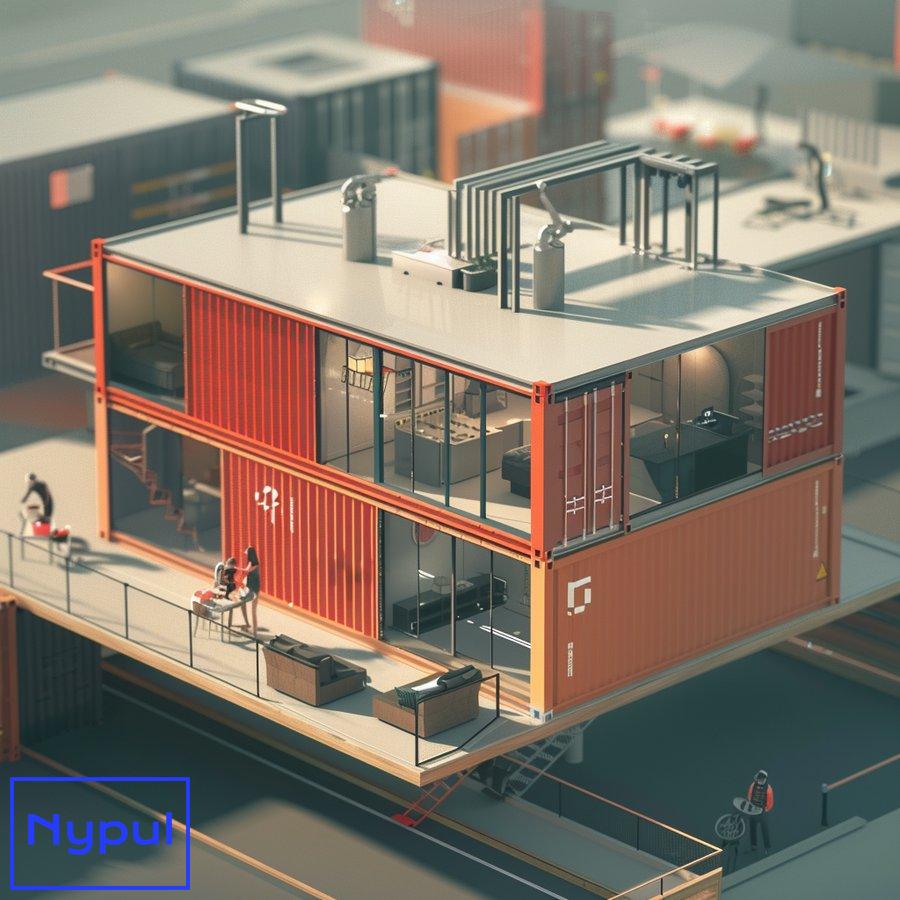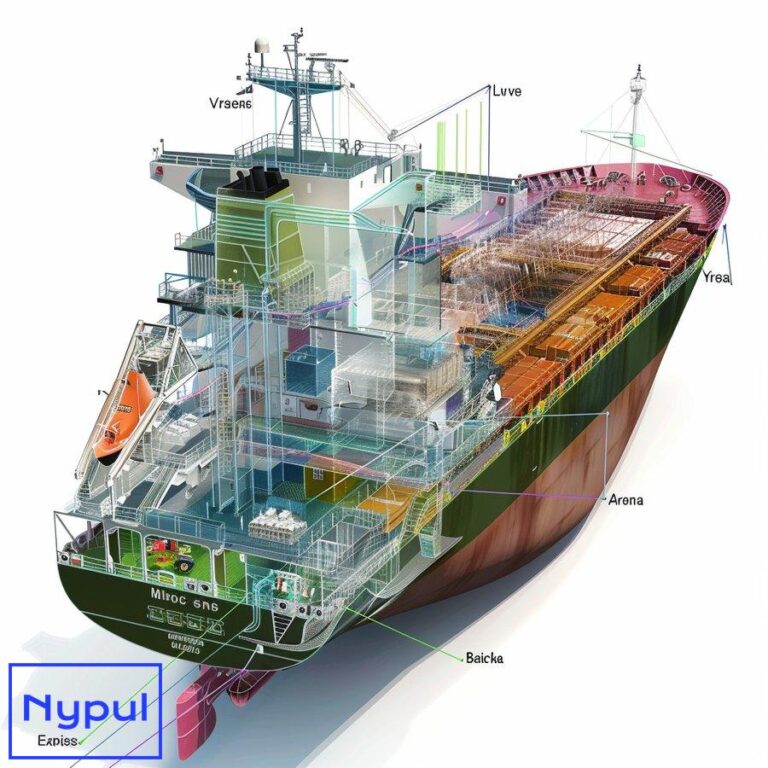How Are Shipping Containers Sustainable
What makes shipping containers environmentally friendly?

Shipping containers are considered environmentally friendly for several reasons. First and foremost, they are made of durable Corten steel that can withstand harsh conditions and last for over 25 years with proper maintenance. This longevity reduces the need for frequent replacement and minimizes waste. Additionally, shipping containers can be easily repurposed and reused for various applications, such as storage buildings, living spaces, work areas, bathrooms, retail spaces, and offices. By giving shipping containers a second life, we reduce the demand for new construction materials and minimize waste.
Another factor that contributes to the environmental friendliness of shipping containers is their modular design. Shipping containers are part of the larger modular construction movement, which involves creating construction elements in a factory instead of on-site. This approach reduces the environmental impact of construction by minimizing waste, saving time, and conserving resources. Studies have shown that factory-produced buildings can produce up to 45% less carbon than traditional construction methods.
Shipping containers are also made of recyclable materials, which further enhances their sustainability. When a shipping container reaches the end of its useful life, it can be recycled into new products, such as furniture, art, or even medical devices. This circular economy approach helps to reduce waste and conserve natural resources.
| Benefit | Description |
|---|---|
| Durability | Shipping containers are made of Corten steel that can last for over 25 years with proper maintenance. |
| Repurposing | Shipping containers can be easily repurposed and reused for various applications, reducing waste and demand for new materials. |
| Modular Construction | Shipping containers are part of the modular construction movement, which reduces the environmental impact of construction. |
| Recyclability | Shipping containers are made of recyclable materials, allowing them to be repurposed into new products at the end of their useful life. |
In summary, shipping containers are considered environmentally friendly due to their durability, repurposing potential, modular construction benefits, and recyclability. By embracing the use of shipping containers, we can reduce waste, conserve resources, and promote sustainable practices in various industries.
How do shipping containers contribute to sustainable construction?
Shipping containers play a significant role in sustainable construction by providing a versatile and eco-friendly alternative to traditional building materials. Their modular design and durability make them well-suited for a wide range of construction projects, from temporary structures to permanent buildings.
One of the primary ways shipping containers contribute to sustainable construction is by reducing waste. When a building reaches the end of its lifespan, the materials used in its construction often end up in landfills. However, shipping containers can be easily repurposed and reused, minimizing the amount of waste generated during the construction process. This approach aligns with the principles of a circular economy, where materials are kept in use for as long as possible before being recycled or repurposed.

Moreover, shipping containers can be modified in a factory setting before being transported to the construction site. This off-site fabrication reduces the environmental impact of on-site construction activities, such as noise pollution, dust, and waste generation. Additionally, factory modifications allow for more precise and efficient use of materials, reducing material waste and minimizing the carbon footprint of the construction process.
Shipping containers also contribute to sustainable construction by reducing the demand for traditional building materials, such as wood and concrete. The production of these materials can have significant environmental impacts, including deforestation, habitat destruction, and greenhouse gas emissions. By using shipping containers as building blocks, we can reduce the need for these materials and promote more sustainable construction practices.
| Benefit | Description |
|---|---|
| Reduced Waste | Shipping containers can be easily repurposed and reused, minimizing waste generated during construction. |
| Off-Site Fabrication | Shipping containers can be modified in a factory setting, reducing the environmental impact of on-site construction activities. |
| Reduced Demand for Traditional Materials | Using shipping containers reduces the need for traditional building materials like wood and concrete, which have significant environmental impacts. |
| Adaptability | Shipping containers can be stacked, connected, or cut to create various architectural styles and layouts, promoting sustainable construction. |
In addition to their environmental benefits, shipping containers also offer practical advantages for sustainable construction projects. Their modular design allows for easy transportation and installation, reducing the time and resources required for on-site construction. Furthermore, shipping containers can be adapted to various climates and locations, making them suitable for a wide range of sustainable construction projects, from affordable housing to disaster relief shelters.
Can shipping containers be energy-efficient?
Yes, shipping containers can be energy-efficient when properly designed and modified. Their inherent characteristics, such as being hermetically sealed and compact in size, make them suitable for energy-efficient construction. However, to achieve optimal energy efficiency, shipping containers often require additional modifications and the incorporation of sustainable technologies.
One of the key advantages of shipping containers in terms of energy efficiency is their compact size. Because shipping containers are relatively small compared to traditional buildings, they require less energy to heat and cool. This compact size also allows for more efficient use of space, reducing the overall energy footprint of the structure.
Moreover, shipping containers are designed to be hermetically sealed, which means they have a high level of air tightness. This air tightness helps to minimize air leaks and drafts, reducing the amount of energy needed to maintain a comfortable indoor climate. However, it’s important to note that while shipping containers are designed to be airtight, they may require additional insulation and sealing measures to achieve optimal energy efficiency.
To further enhance the energy efficiency of shipping containers, various sustainable technologies can be incorporated, such as:
Solar panels: Installing solar panels on the roof or walls of a shipping container can provide a renewable source of energy, reducing the reliance on fossil fuels and lowering the overall energy consumption of the structure.
Energy-efficient windows and doors: Replacing standard windows and doors with energy-efficient models can significantly improve the thermal performance of a shipping container, reducing heat loss and minimizing the need for heating and cooling.
Insulation: Adding high-quality insulation to the walls, floor, and ceiling of a shipping container can help to regulate the indoor temperature, reducing the energy required for heating and cooling.
LED lighting: Using energy-efficient LED lighting can reduce the electricity consumption of a shipping container while providing adequate illumination for the interior space.
| Benefit | Description |
|---|---|
| Compact Size | Shipping containers require less energy to heat and cool due to their small size compared to traditional buildings. |
| Hermetically Sealed | Shipping containers are designed to be airtight, reducing air leaks and drafts, which helps to minimize energy consumption. |
| Solar Panels | Installing solar panels on shipping containers provides a renewable source of energy, reducing reliance on fossil fuels. |
| Energy-Efficient Windows and Doors | Replacing standard windows and doors with energy-efficient models improves thermal performance and reduces heat loss. |
| Insulation | Adding high-quality insulation to shipping containers helps regulate indoor temperature and minimize energy required for heating and cooling. |
| LED Lighting | Using energy-efficient LED lighting reduces electricity consumption while providing adequate illumination. |
By incorporating these sustainable technologies and design principles, shipping containers can be transformed into highly energy-efficient structures that contribute to a more sustainable built environment.
How do shipping containers reduce transportation emissions?
Shipping containers play a significant role in reducing transportation emissions by optimizing the logistics of global trade. Their standardized design and efficient stacking capabilities allow for the consolidation of freight, minimizing the number of vehicles required to transport goods. This optimization leads to a reduction in fuel consumption and greenhouse gas emissions associated with transportation.
One of the primary ways shipping containers reduce transportation emissions is by enabling intermodal transportation. Intermodal transportation involves the seamless transfer of cargo between different modes of transportation, such as ships, trains, and trucks, without the need to unload and reload the goods. This process is facilitated by the standardized size and design of shipping containers, which can be easily transferred between different modes of transportation. By reducing the number of times goods need to be handled, intermodal transportation minimizes the carbon footprint of the supply chain.
Moreover, shipping containers are designed to be stackable, allowing for efficient utilization of space in transportation vehicles. This stacking capability enables the transportation of more goods per vehicle, reducing the number of trips required and the associated emissions. Additionally, the durability of shipping containers reduces the need for frequent replacement, further minimizing the environmental impact of transportation.
| Benefit | Description |
|---|---|
| Freight Consolidation | Shipping containers allow for the consolidation of freight, reducing the number of vehicles required for transportation. |
| Intermodal Transportation | Shipping containers facilitate intermodal transportation, enabling seamless transfer between different modes of transportation. |
| Efficient Stacking | Shipping containers are designed to be stackable, allowing for efficient utilization of space in transportation vehicles. |
| Durability | The durability of shipping containers reduces the need for frequent replacement, minimizing the environmental impact of transportation. |
Furthermore, the standardized design of shipping containers enables the optimization of transportation routes and schedules. By using data analytics and logistics software, transportation companies can identify the most efficient routes and minimize empty backhauls, where vehicles return to their origin without cargo. This optimization leads to a reduction in fuel consumption and emissions, contributing to a more sustainable transportation system.
It’s important to note that while shipping containers play a significant role in reducing transportation emissions, the overall environmental impact of the supply chain also depends on other factors, such as the fuel efficiency of transportation vehicles and the use of alternative fuels like biofuels or electric power.
Why are shipping containers considered durable and long-lasting?

Shipping containers are considered durable and long-lasting due to their robust construction and materials. They are designed to withstand the harsh conditions encountered during ocean voyages, including exposure to saltwater, high winds, and heavy loads. This durability makes shipping containers well-suited for a wide range of applications, from storage to construction.
One of the key factors contributing to the durability of shipping containers is the use of Corten steel in their construction. Corten steel, also known as weathering steel, is a type of steel alloy that forms a protective rust-like appearance when exposed to the elements. This rust-like patina helps to protect the underlying steel from further corrosion, making Corten steel highly resistant to weathering and wear. Shipping containers made from Corten steel can last for over 25 years with proper maintenance.
In addition to their steel construction, shipping containers are designed with a focus on strength and durability. They feature a robust frame, reinforced corners, and thick walls that provide structural integrity and protection against external forces. This design allows shipping containers to support heavy loads without compromising their integrity, making them suitable for stacking and supporting the weight of other containers.
Moreover, shipping containers are designed to be easily repaired and maintained. If a container sustains damage during transportation or use, it can often be repaired by welding or replacing specific components. This repairability extends the lifespan of shipping containers and reduces the need for frequent replacement, contributing to their long-lasting nature.
| Characteristic | Description |
|---|---|
| Corten Steel | Shipping containers are made from Corten steel, a highly durable and corrosion-resistant alloy that can last for over 25 years with proper maintenance. |
| Robust Design | Shipping containers feature a strong frame, reinforced corners, and thick walls that provide structural integrity and support heavy loads. |
| Repairability | Shipping containers can be easily repaired by welding or replacing specific components, extending their lifespan and reducing the need for replacement. |
| Resistance to Elements | Shipping containers are designed to withstand harsh conditions encountered during ocean voyages, including exposure to saltwater, high winds, and heavy loads. |
The durability and long-lasting nature of shipping containers make them an attractive option for various applications, from storage and transportation to construction and repurposing. By choosing durable and long-lasting materials, we can reduce waste, conserve resources, and promote sustainable practices in various industries.
What are the economic benefits of sustainable shipping container use?
The use of shipping containers in sustainable construction and logistics offers several economic benefits that make them an attractive option for businesses and individuals alike. These benefits range from cost savings to increased efficiency and flexibility.
One of the primary economic benefits of using shipping containers is their affordability. Shipping containers are mass-produced and readily available, making them relatively inexpensive compared to traditional construction materials. Additionally, the simplicity of their design allows for faster modifications and construction, saving both time and labor costs. This cost-effectiveness opens the door to sustainable construction for a wider range of individuals and organizations, making it more accessible and attainable.
Moreover, the durability and longevity of shipping containers contribute to their economic benefits. As mentioned earlier, shipping containers made from Corten steel can last for over 25 years with proper maintenance. This extended lifespan means that businesses and individuals can rely on their investment for a significant period, reducing the need for frequent replacement and associated costs.
Another economic benefit of using shipping containers is their versatility and adaptability. Shipping containers can be easily modified, stacked, and connected to create various architectural styles and layouts. This flexibility allows businesses to tailor their space to their specific needs, reducing the need for costly custom construction. Additionally, shipping containers can be easily relocated if a business expands or moves to a new location, reducing the costs associated with demolition and rebuilding.
| Benefit | Description |
|---|---|
| Affordability | Shipping containers are relatively inexpensive compared to traditional construction materials due to mass production and simple design. |
| Durability and Longevity | Shipping containers made from Corten steel can last for over 25 years with proper maintenance, reducing the need for frequent replacement. |
| Versatility and Adaptability | Shipping containers can be easily modified, stacked, and connected to create various architectural styles and layouts, reducing the need for costly custom construction. |
| Reduced Transportation Costs | The standardized design and efficient stacking capabilities of shipping containers optimize logistics and reduce transportation costs. |
| Increased Efficiency | The use of shipping containers in sustainable construction and logistics can increase efficiency through modular design and off-site fabrication. |
Furthermore, the use of shipping containers in sustainable construction and logistics can lead to reduced transportation costs. As mentioned earlier, the standardized design and efficient stacking capabilities of shipping containers optimize logistics and reduce the number of vehicles required for transportation. This optimization leads to a reduction in fuel consumption and associated costs, contributing to the overall economic benefits of using shipping containers.
Finally, the use of shipping containers in sustainable construction and logistics can increase efficiency through modular design and off-site fabrication. By manufacturing components in a controlled factory setting, businesses can reduce waste, minimize construction time, and ensure quality control. This increased efficiency translates into cost savings and improved profitability for businesses that embrace sustainable shipping container use.
Challenges in Shipping Container Sustainability
While shipping containers offer numerous environmental and economic benefits, there are also some challenges associated with their use in sustainable construction and logistics. Understanding these challenges is crucial for businesses and individuals looking to adopt sustainable shipping container practices.
One of the primary challenges is the perception of shipping containers as an unconventional building material. Despite their growing popularity, some people may be hesitant to use shipping containers due to concerns about their appearance or perceived limitations in design flexibility. Overcoming this perception requires education and showcasing successful examples of shipping container projects that demonstrate their versatility and aesthetic appeal.
Another challenge is the availability and condition of used shipping containers. While there are millions of shipping containers sitting empty at ports worldwide, not all of them are suitable for repurposing or construction. Some containers may have sustained significant damage during transportation or have been exposed to hazardous materials, making them unsuitable for reuse. Businesses looking to use shipping containers must carefully inspect and assess the condition of available containers to ensure they meet safety and quality standards.
| Challenge | Description |
|---|---|
| Perception of Unconventionality | Some people may be hesitant to use shipping containers due to concerns about their appearance or perceived limitations in design flexibility. |
| Availability and Condition of Used Containers | Not all used shipping containers are suitable for repurposing or construction due to damage or exposure to hazardous materials. |
| Regulatory and Building Code Compliance | Shipping container projects may face challenges in meeting local building codes and regulations, which can vary depending on the location and type of project. |
| Insulation and Climate Control | Shipping containers may require additional insulation and climate control measures to achieve optimal energy efficiency, which can add to the cost and complexity of the project. |
| Lack of Awareness and Education | There may be a lack of awareness and education among the general public and construction professionals about the benefits and best practices of using shipping containers in sustainable construction and logistics. |
Additionally, shipping container projects may face challenges in meeting local building codes and regulations, which can vary depending on the location and type of project. Navigating these regulatory requirements can be time-consuming and costly, potentially deterring some businesses from pursuing shipping container projects.
Another challenge is ensuring adequate insulation and climate control in shipping container projects. While shipping containers can be energy-efficient due to their compact size and airtight design, they may require additional insulation and climate control measures to achieve optimal energy efficiency. This can add to the cost and complexity of the project, particularly in extreme climates.
Finally, there may be a lack of awareness and education among the general public and construction professionals about the benefits and best practices of using shipping containers in sustainable construction and logistics. Overcoming this challenge requires ongoing education and advocacy efforts to promote the advantages of shipping container use and share successful case studies.
Despite these challenges, the benefits of using shipping containers in sustainable construction and logistics continue to drive innovation and adoption. As more businesses and individuals embrace the use of shipping containers, the challenges will likely be addressed through improved education, regulatory changes, and the development of new technologies## Conclusion
Shipping containers represent a transformative approach to sustainability in construction and logistics. Their environmentally friendly characteristics, such as durability, repurposing potential, and energy efficiency, make them a valuable asset in the pursuit of sustainable practices. By reducing waste, minimizing transportation emissions, and offering economic benefits, shipping containers pave the way for innovative solutions in various industries.
The challenges associated with shipping container sustainability, including perceptions of unconventionality, regulatory compliance, and the need for adequate insulation, can be addressed through education, advocacy, and technological advancements. As awareness of the benefits of shipping containers grows, more businesses and individuals are likely to explore their potential, leading to a more sustainable future.
In summary, shipping containers are not just a means of transportation; they are a versatile and sustainable building solution that can significantly contribute to environmental conservation and economic efficiency. Embracing shipping containers as a sustainable alternative in construction and logistics can lead to innovative designs, reduced carbon footprints, and a more responsible approach to resource management.
Future Directions
The future of shipping container sustainability looks promising, with ongoing innovations and trends that are shaping how these structures are utilized. As the demand for sustainable solutions continues to rise, several key developments can be anticipated:

Integration of Smart Technologies: The incorporation of smart technologies into shipping container designs can enhance their energy efficiency and functionality. Smart sensors can monitor energy consumption, temperature, and humidity levels, allowing for real-time adjustments to optimize energy use.
Increased Use in Urban Development: As urban areas face challenges related to housing shortages and rising construction costs, shipping containers are increasingly being recognized as a viable solution for affordable housing. Their modular nature allows for rapid deployment and adaptability to various urban environments.
Sustainable Materials and Practices: The trend toward sustainability is leading to the exploration of alternative materials and practices in shipping container construction. This includes the use of recycled insulation materials, green roofing systems, and eco-friendly finishes that further enhance the environmental benefits of shipping containers.
Collaboration and Partnerships: Collaborative efforts between governments, NGOs, and private sector organizations can drive the adoption of shipping containers in sustainable development projects. By pooling resources and expertise, stakeholders can create innovative solutions that address housing, transportation, and environmental challenges.
Educational Initiatives: Increased awareness and education about the benefits of shipping containers are essential for overcoming existing challenges. Workshops, seminars, and online resources can help inform architects, builders, and the general public about the potential of shipping containers in sustainable construction.
| Future Direction | Description |
|---|---|
| Integration of Smart Technologies | Incorporating smart technologies into shipping container designs can enhance energy efficiency and functionality. |
| Increased Use in Urban Development | Shipping containers are recognized as a viable solution for affordable housing in urban areas facing housing shortages. |
| Sustainable Materials and Practices | The exploration of alternative materials and practices can further enhance the environmental benefits of shipping containers. |
| Collaboration and Partnerships | Collaborative efforts can drive the adoption of shipping containers in sustainable development projects. |
| Educational Initiatives | Increased awareness and education about shipping containers can help overcome existing challenges and promote their benefits. |
As we look to the future, it is clear that shipping containers hold immense potential for contributing to a more sustainable world. By embracing innovative practices and fostering collaboration, we can unlock the full capabilities of shipping containers as a sustainable solution in construction and logistics.
Final Thoughts
The journey toward sustainability is ongoing, and shipping containers are a testament to the possibilities that lie ahead. Their unique characteristics and versatility offer a pathway to reduce environmental impact while providing economic benefits. By recognizing the value of shipping containers and addressing the challenges they present, we can work together to create a more sustainable future for generations to come.
Through continued innovation, education, and collaboration, shipping containers can play a pivotal role in reshaping our approach to construction, logistics, and resource management. As we embrace these sustainable practices, we not only contribute to environmental conservation but also pave the way for a more resilient and adaptable built environment.
In conclusion, the sustainable use of shipping containers is not just a trend; it is a movement toward a more responsible and efficient future. By leveraging their potential, we can make significant strides in creating a more sustainable world, one shipping container at a time.






